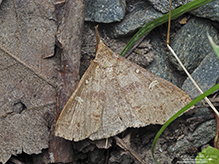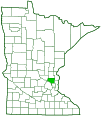speckled renia moth
(Renia adspergillus)
Conservation • Description • Habitat • Ecology • Distribution • Taxonomy
|
||||||||
| Hodges # | 8386 |
|||||||
Conservation Status |
||||||||
| IUCN Red List | not listed |
|||||||
| NatureServe | NNR - Unranked |
|||||||
| Minnesota | not listed |
|||||||
Description |
||
Speckled renia moth is a common, medium-sized, litter moth. It occurs in the eastern United States from Maine to Florida, west to Wisconsin and Texas. It also occurs in southern Canada from Nova Scotia to Ontario. Minnesota is outside of the moth’s known range, but there is a single record in the state. It was recorded on July 26, 1969, in the former Carlos Avery Game Refuge, now part of the Carlos Avery Wildlife Management Area. Little information can be found about the biology of this moth. The larvae probably feed on dead leaves and other organic debris, like other litter moths. Adults are active in the north from May to September. They are found in both forested and open areas. Adults are roughly triangular in shape (deltoid). Males have a 1 3⁄16″ (30 mm) wingspan. Females are smaller, with a 1 1⁄16″ (27 mm) wingspan. The sensory mouthparts (labial palps) are long, blade-like, and hairy. On the male they are curved upward. On the female they are projected forward, curved upward just at the tip. The forewings are broad. The outer margin is convex and not angled. The ground color is pale gray. The entire surface is flecked with light brown and dark brown scales. The antemedial (AM) and postmedial (PM) lines are dark and strongly toothed. The AM line is strongly curved downward – toward the outer margin. The median band is broad, dark, and diffuse. The subterminal (ST) line is pale, thin, irregular, and usually broken. The PM line is not marked by dark dots. Above the ST line there is a series of thick, dark dots on the veins. The terminal line is represented by a row of dark dots. The round spot in the upper median area (orbicular spot) is small and pale yellowish, and it usually has a dark outline. The kidney-shaped spot (reniform spot) in the lower median area is pale yellowish, and it sometimes has a dark, crescent-shaped mark in the middle. The hindwings are the same color as the forewings. The PM and ST lines are inconspicuous. |
||
Size |
||
Male wingspan: 1 3⁄16″ (30 mm) Female wingspan: 1 1⁄16″ (27 mm) |
||
Similar Species |
||
Habitat |
||
Forested and open areas |
||
Ecology |
||
Season |
||
One generation per year in the north: May to September |
||
Behavior |
||
Adults are active at night and will come to lights. |
||
Life Cycle |
||
|
||
Larva Food |
||
Dead leaves and other organic debris |
||
Adult Food |
||
|
||
Distribution |
||||
|
Sources |
|||
| 12/17/2023 | ||||
Occurrence |
||||
Not known in Minnesota except for one historic record |
||||
Taxonomy |
|||
Order |
Lepidoptera (Butterflies and Moths) | ||
Superfamily |
Noctuoidea (Owlet Moths and Allies) | ||
Family |
Erebidae (Underwing, Tiger, Tussock, and Allied Moths) | ||
Subfamily |
Herminiinae (litter moths) | ||
Genus |
Renia (renia moths) | ||
Until recently, the subfamily Herminiinae was treated either as the separate family Herminiidae or as a subfamily of Noctuidae. A molecular phylogenetic analysis of the family Erebidae (Zahiri, Reza; et al., 2011) determined that Herminiinae are closely related to Aganainae, which is a subfamily of Erebidae, and Herminiinae was moved as a whole to Erebidae. |
|||
Synonyms |
|||
Crambus adspergillus Renia larvalis Renia restrictalis |
|||
Common Names |
|||
gray renia speckled renia speckled renia moth |
|||
Glossary
Antemedial (AM) line
A thin line separating the basal area and the median area of the forewing of Lepidoptera.
Orbicular spot
A circular spot or outline in the upper median area near the antemedial line on the forewing of many moths.
Palp
Short for pedipalp. A segmented, finger-like process of an arthropod; one is attached to each maxilla and two are attached to the labium. They function as sense organs in spiders and insects, and as weapons in scorpions. Plural: palpi or palps.
Postmedial (PM) line
A thin line separating the median area and the postmedial area of the forewing of Lepidoptera.
Reniform spot
A kidney-shaped spot or outline in the lower median area near the PM line on the forewing of many moths.
Visitor Photos |
|||||
Share your photo of this insect. |
|||||
| This button not working for you? Simply email us at info@MinnesotaSeasons.com. Attach one or more photos and, if you like, a caption. |
|||||
Alfredo Colon |
|||||
 |
|||||
MinnesotaSeasons.com Photos |
|||||
|
|||||

Slideshows |
||

Visitor Videos |
|||
Share your video of this insect. |
|||
| This button not working for you? Simply email us at info@MinnesotaSeasons.com. Attach a video, a YouTube link, or a cloud storage link. |
|||
Other Videos |
|||
| Red eyes of the Speckled Renia Moth Insects and Animals |
|||
About
Aug 20, 2023 |
|||

Created: 12/17/2023
Last Updated:


